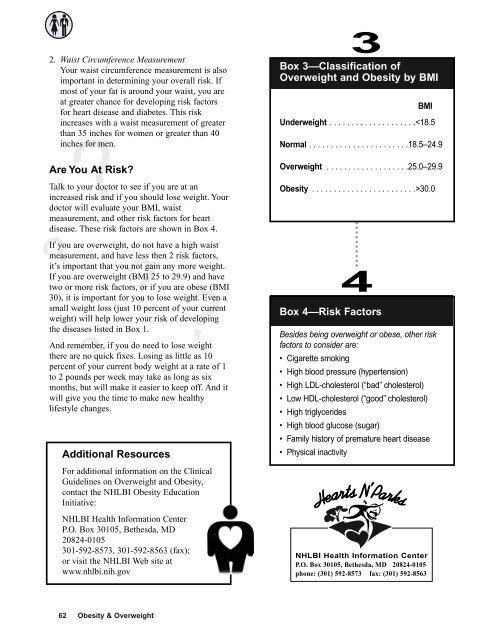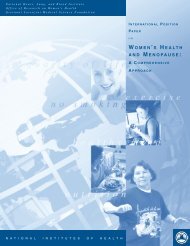HeartsNParks Community Mobilization Guide - National Heart, Lung ...
HeartsNParks Community Mobilization Guide - National Heart, Lung ...
HeartsNParks Community Mobilization Guide - National Heart, Lung ...
Create successful ePaper yourself
Turn your PDF publications into a flip-book with our unique Google optimized e-Paper software.
?<br />
2. Waist Circumference Measurement<br />
Your waist circumference measurement is also<br />
important in determining your overall risk. If<br />
most of your fat is around your waist, you are<br />
at greater chance for developing risk factors<br />
for heart disease and diabetes. This risk<br />
increases with a waist measurement of greater<br />
than 35 inches for women or greater than 40<br />
inches for men.<br />
?<br />
Are You At Risk?<br />
Talk to your doctor to see if you are at an<br />
increased risk and if you should lose weight. Your<br />
doctor will evaluate your BMI, waist<br />
measurement, and other risk factors for heart<br />
disease. These risk factors are shown in Box 4.<br />
If you are overweight, do not have a high waist<br />
measurement, and have less then 2 risk factors,<br />
it’s important that you not gain any more weight.<br />
If you are overweight (BMI 25 to 29.9) and have<br />
two or more risk factors, or if you are obese (BMI<br />
30), it is important for you to lose weight. Even a<br />
small weight loss (just 10 percent of your current<br />
weight) will help lower your risk of developing<br />
the diseases listed in Box 1.<br />
?<br />
?<br />
62 Obesity & Overweight<br />
?<br />
And remember, if you do need to lose weight<br />
there are no quick fixes. Losing as little as 10<br />
percent of your current body weight at a rate of 1<br />
to 2 pounds per week may take as long as six<br />
months, but will make it easier to keep off. And it<br />
will give you the time to make new healthy<br />
lifestyle changes.<br />
Additional Resources<br />
For additional information on the Clinical<br />
<strong>Guide</strong>lines on Overweight and Obesity,<br />
contact the NHLBI Obesity Education<br />
Initiative:<br />
NHLBI Health Information Center<br />
P.O. Box 30105, Bethesda, MD<br />
20824-0105<br />
301-592-8573, 301-592-8563 (fax);<br />
or visit the NHLBI Web site at<br />
www.nhlbi.nih.gov<br />
3<br />
Box 3—Classification of<br />
Overweight and Obesity by BMI<br />
BMI<br />
Underweight . . . . . . . . . . . . . . . . . . . .30.0<br />
4<br />
Box 4—Risk Factors<br />
Besides being overweight or obese, other risk<br />
factors to consider are:<br />
• Cigarette smoking<br />
• High blood pressure (hypertension)<br />
• High LDL-cholesterol (“bad” cholesterol)<br />
• Low HDL-cholesterol (“good” cholesterol)<br />
• High triglycerides<br />
• High blood glucose (sugar)<br />
• Family history of premature heart disease<br />
• Physical inactivity<br />
NHLBI Health Information Center<br />
P.O. Box 30105, Bethesda, MD 20824-0105<br />
phone: (301) 592-8573 fax: (301) 592-8563
















